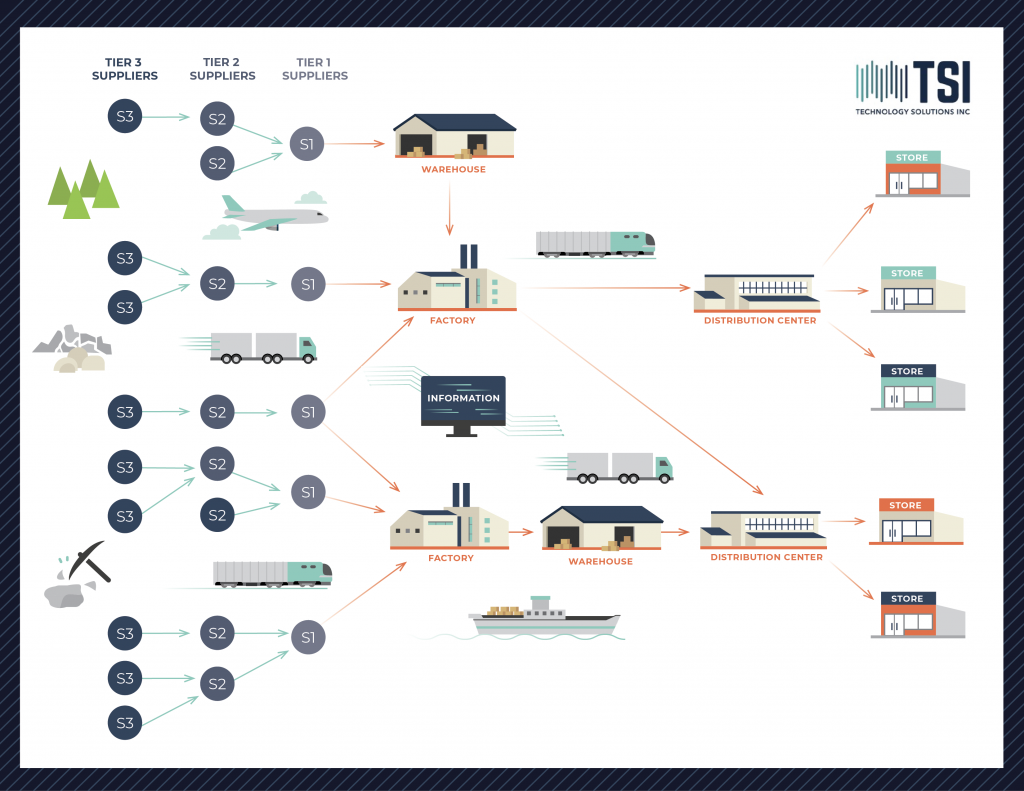5 Tips For Retailers On How To Deal With Supply Chain Issues

Supply chain issues are becoming increasingly disruptive across the U.S. If you’re a retailer, you’ve probably experienced the impact of these issues in some way, shape, or form within the past year. Common hurdles in the retail industry such as material shortages, manufacturing plant shutdowns or shipping delays have made it increasingly difficult for retailers to maintain the natural ebb and flow of business.
Although we can’t solve these issues, we can help provide a few tips to help retailers navigate the choppy waters of the supply chain.
Understanding The Supply Chain
In order to understand why these supply chain issues are occurring, it’s important to first understand exactly how the supply chain works. For some, this information may be a bit rudimentary, but we feel it’s important to have a clear baseline understanding of the problem before you can focus on a solution.
A supply chain, as defined by Investopedia, is “a network between a company and its suppliers to produce and distribute a specific product to the final buyer.” or simply put, the process of getting a product from point A to point B.
The Supply Chain Process – A Printer’s Journey
The supply chain is a complex concept that can be difficult to visualize, so let’s simplify it a bit by thinking about it in terms of just one product. If you were to hop on your laptop and purchase a printer, there are a series of processes that will need to occur before that printer can be delivered to your doorstep.
A printer, like many products, is made up of various components such as a sheet feeder, control panel, cartridge cover, output tray, etc. Each of these components is manufactured separately and then shipped to a plant where they’re assembled into a final product. Depending on the type of product, this process can be very complex, where various shipments of materials and parts are needed before a final product can be assembled.
Once your printer is assembled, it then needs to be shipped to a warehouse. Oftentimes, the manufacturing plants where the products are assembled are located overseas, meaning that products must be shipped via an aircraft or sea freight carrier. Once your printer arrives at the warehouse, it will then be shipped to a distribution center and then finally to your home address.

*The supply & distribution process may differ from the description and graphic above depending on the product, industry and other outside factors
Supply Chain Disruptions
As you can see, the supply chain is highly interconnected meaning that if just one shipment is delayed or disrupted, it can have a major impact on the entire process. A few common supply chain disruptions include:
- Worker Shortages – Not enough workers are available to collect raw materials which can result in material shortages.
- Material Shortages – Not enough raw materials available to manufacture parts.
- Inflation – Shipping costs increase making it more expensive for companies to transport goods.
- Manufacturing Plant & Factory Closures – Many manufacturing locations have closed due to worker shortages which results in fewer goods being produced.
- Port Delays – Goods sit at ports for long periods of time waiting to be unloaded and shipped to warehouses.
- Sickness & Natural Disasters – When certain countries are hit hard by an outbreak of disease or a natural disaster, this can be largely disruptive to supply chains for companies who do business in those regions.
- Sharp Increases in Demand – When demand outweighs supply, it’s difficult for the supply chain to keep up and often results in shortages.
Oftentimes these disruptions occur sporadically, making it easier for businesses to respond and make adjustments. In recent times, however, these disruptions have been occurring simultaneously which has resulted in a steep uptick in delays and shortages.
5 Tips for Dealing With Supply Chain Issues
Although supply chain issues may be a pain to deal with, they can be managed. We’ve put together a few tips for retailers on how to better navigate these issues and get business back on track.
1) Closely Monitor Inventory Data
Inventory management is always important, but even more so when experiencing supply shortages or shipping delays. Make sure that you stay on top of your current supply and allow enough time for goods to be shipped before you run out of inventory. You may also want to consider expanding your inventory storage or warehouse capacity so that you’re able to store more goods locally.
2) Study Consumer Trends
Along with monitoring your inventory, it’s also important to keep tabs on consumer behavior. Understanding demand and staying up-to-date on retail trends can help you make more informed decisions on how much inventory you’ll need. You’ll want to make sure that you’re tracking the overall demand within your industry and the specific demand for your products or services. The more prepared you are for a spike in demand, the better you’ll be able to manage it.
3) Understand Supplier Timelines
In addition to managing your own timelines, you’ll also need to understand the timelines of your suppliers. If a specific supplier is experiencing extreme disruptions due to factory closures or worker shortages, it’s important to communicate with them to better understand their situation. This communication will help you plan ahead and make adjustments – whether that’s to alert your customers of the delay or to look into additional supply options. Either way, the more transparency you have into their process the better.
4) Be Proactive Instead of Reactive
This one may seem obvious, but we’ve witnessed many retailers who optimistically think “that won’t happen to me” and then it does. Our best advice is to assume the worst and always be prepared. To do this, we recommend making inventory adjustments, getting quotes from other suppliers, ordering goods in advance, and cutting costs where you can. It never hurts to be over-prepared, especially when the alternative can spell disaster for your business.
5) Opt for Device Repair Instead of Purchasing New Models
The supply chain for technology has unarguably been hit hard. Many consumers are being forced to join waitlists for things like cell phones or computer parts. The same struggle applies to retailers. When it comes to the devices you use as a business such as POS systems or tablets, we would highly recommend getting them serviced rather than buying replacements. By the time you finally receive your new device, you could have had the old one serviced and returned to you months ago.
At TSI, we can service all types of retail devices that range in make and model. Our repair process is simple – you ship us your device, our experienced technicians make all necessary repairs, and then we ship it right back to you. We’re based in the U.S. so shipments don’t need to travel overseas which can save you a ton of time, money, and hassle. Contact us today for a quote and we can help you get your business back on track.
Supply Chain Issue FAQs
What Are The Major Supply Chain Issues?
Keeping transportation costs down. Keeping up with customer/industry demands. Sourcing consistent, reliable carrier capacity. Keeping up with the latest technology solutions and demands.
Why Are There Supply Chain Issues?
Analysts say that the lingering effects of COVID-19 responses essentially reduced the production of goods and services. The supply-chain shortages now, they say, are the result of struggles to return to pre-pandemic production levels.
How Do You Fix A Supply Chain Problem?
3 Steps to Fixing Supply Chain Disruptions 1. Review and Measure Data. Today’s supply chain practitioner must have access to accurate, up to the minute data at all times. 2. Review Your Options. Utilizing data to spot a potential supply chain disruption is only the first step. 3. Collaborate with Your Network.
What Are The Effects Of Supply Chain Disruption?
Supply chain disruptions do not just create higher prices and shortages among high-end consumer products, such as cars. They also affect more-basic commodities such as generic drugs or energy, increasing the cost of living and the provision of basic needs.